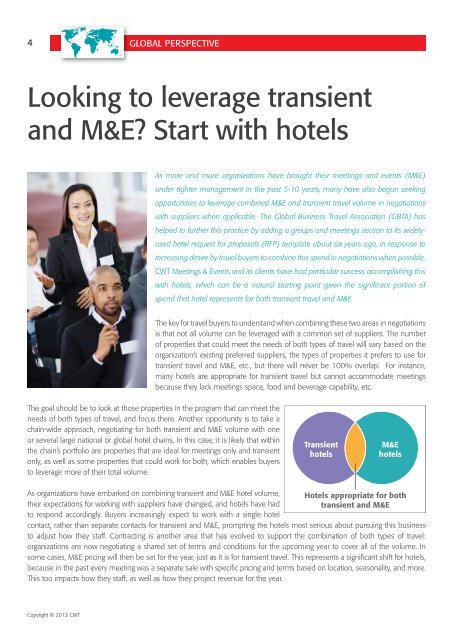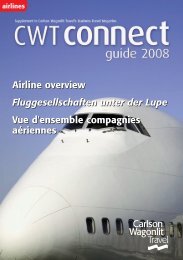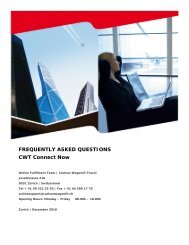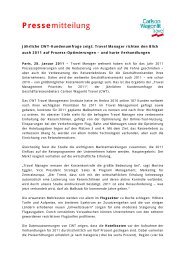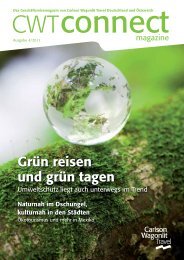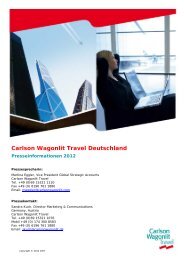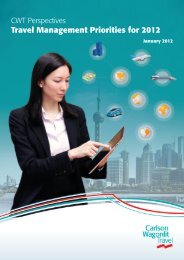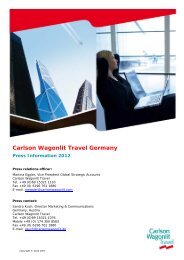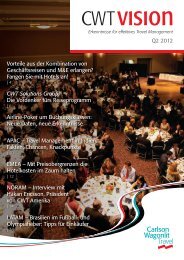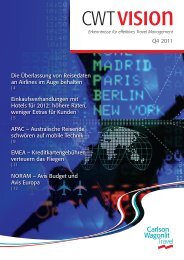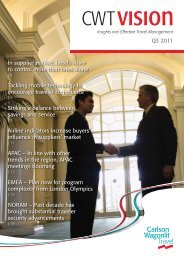CWT Solutions Group - Carlson Wagonlit Travel
CWT Solutions Group - Carlson Wagonlit Travel
CWT Solutions Group - Carlson Wagonlit Travel
Create successful ePaper yourself
Turn your PDF publications into a flip-book with our unique Google optimized e-Paper software.
4<br />
Copyright © 2012 <strong>CWT</strong><br />
GLOBAL PERSPECTIVE<br />
Looking to leverage transient<br />
and M&E? Start with hotels<br />
The goal should be to look at those properties in the program that can meet the<br />
needs of both types of travel, and focus there. Another opportunity is to take a<br />
chain-wide approach, negotiating for both transient and M&E volume with one<br />
or several large national or global hotel chains. In this case, it is likely that within<br />
the chain’s portfolio are properties that are ideal for meetings only and transient<br />
only, as well as some properties that could work for both, which enables buyers<br />
to leverage more of their total volume.<br />
As organizations have embarked on combining transient and M&E hotel volume,<br />
their expectations for working with suppliers have changed, and hotels have had<br />
to respond accordingly. Buyers increasingly expect to work with a single hotel<br />
As more and more organizations have brought their meetings and events (M&E)<br />
under tighter management in the past 5-10 years, many have also begun seeking<br />
opportunities to leverage combined M&E and transient travel volume in negotiations<br />
with suppliers when applicable. The Global Business <strong>Travel</strong> Association (GBTA) has<br />
helped to further this practice by adding a groups and meetings section to its widelyused<br />
hotel request for proposals (RFP) template about six years ago, in response to<br />
increasing desire by travel buyers to combine this spend in negotiations when possible.<br />
<strong>CWT</strong> Meetings & Events and its clients have had particular success accomplishing this<br />
with hotels, which can be a natural starting point given the signifi cant portion of<br />
spend that hotel represents for both transient travel and M&E.<br />
The key for travel buyers to understand when combining these two areas in negotiations<br />
is that not all volume can be leveraged with a common set of suppliers. The number<br />
of properties that could meet the needs of both types of travel will vary based on the<br />
organization’s existing preferred suppliers, the types of properties it prefers to use for<br />
transient travel and M&E, etc., but there will never be 100% overlap. For instance,<br />
many hotels are appropriate for transient travel but cannot accommodate meetings<br />
because they lack meetings space, food and beverage capability, etc.<br />
Transient<br />
hotels<br />
M&E<br />
hotels<br />
Hotels appropriate for both<br />
transient and M&E<br />
contact, rather than separate contacts for transient and M&E, prompting the hotels most serious about pursuing this business<br />
to adjust how they staff . Contracting is another area that has evolved to support the combination of both types of travel:<br />
organizations are now negotiating a shared set of terms and conditions for the upcoming year to cover all of the volume. In<br />
some cases, M&E pricing will then be set for the year, just as it is for transient travel. This represents a signifi cant shift for hotels,<br />
because in the past every meeting was a separate sale with specifi c pricing and terms based on location, seasonality, and more.<br />
This too impacts how they staff , as well as how they project revenue for the year.


